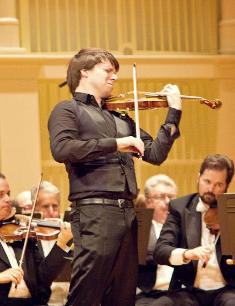
Joshua Bell Matchless in CSO Opener
Sergeant Preston of the Yukon (think “Donna Diana” Overture by Emil Nikolaus von Rezniček) officially opened the Cincinnati Symphony Orchestra’s 2012-13 season Friday night at Music Hall.

But Yukon King was only the lead dog for the performance, which featured Joshua Bell, a “Ravel sandwich” and guest conductor and Cincinnati favorite William Eddins (music director of the Edmonton Symphony Orchestra).
Bell, consummate artist and violinist par excellence, was the star of the show, and even those who have heard Max Bruch’s Concerto No. 1 in G Minor and Camille Saint-Saëns’ Introduction and Rondo Capriccioso hundreds of times would have to concede that the phrase "no one does it better" fits no one better than Bell.
Music Hall was not sold out for the event – for that matter, neither was the season-opening gala Tuesday evening with soprano Renée Fleming. But that is the burden of the over-sized hall (3,516 seats), which desperately needs “revitalization." (Plans to renovate and re-configure the hall are currently stalled, pending an agreement between the City of Cincinnati, owner of Music Hall, and the Music Hall Revitalization Corporation, a private group that wishes to take over ownership and management of the building.)
It was an enthusiastic audience, nonetheless, and they were treated to an outstanding concert, which in addition to Bell’s peerless performance, boasted exceptional playing by the CSO musicians led with flair by the charismatic Eddins.
The “Donna Diana” Overture, not performed on CSO concerts since 1983, made a rousing opener (and a fond bit of recall for those who remember the TV and radio series about the crime-fighting Canadian Mountie Sgt. Preston and his Alaskan Husky Yukon King). Then it was curtain up on Bell, tall and trim in a kind of biker’s tux, who demonstrated compelling musicianship in Bruch’s warhorse Concerto.
All it took was Bell’s opening statement, rising exquisitely and gently from a burnished open G on his ex Huberman Stradivarius (turning 300 next year) to draw the listener into a new and magical world. Bell does not play notes, he makes music, as his more assertive repeat of this opening statement made clear and on into the exposition proper, which he gave heroic dimensions. Again, by contrast, the subordinate theme emerged in satin tones. The second movement (Adagio) was deeply romantic, but with finesse, rising to impassioned climaxes and ending softly and ineffably sweet with Bell and the CSO flutes.
Bell set off fireworks in the Allegro energico finale where, as always, he harnessed technical might to the finest musical ends. Throughout the Concerto, Eddins and the CSO seemed inspired by his playing, which they matched in intensity and spirit.
Bell returned for the all-French second half with Saint-Saëns’ Introduction and Rondo Capriccioso, a popular showpiece written for the great Spanish virtuoso Pablo de Sarasate. It, too, was a revelation in Bells’ hands. The Introduction caressed the ear with its blend of nuance and precision, so much so, that one tended to overlook its technical precision, including rapid staccato bowing, and lap up its sweetness instead. Even so, the daunting Rondo had all the requisite swagger and technical brilliance. Taken at top speed, it generated its own electricity, given added voltage by Eddins and the CSO, with whom Bell worked hand-in-glove.
Despite a rapturous ovation, there was no encore, for what could top, or even follow, the Saint Saëns, which itself served as encore to the Bruch Concerto?
Framing the Saint-Saëns were two works by Ravel, “Valses nobles et sentimentales” and “Rapsodie espagnole.” Eddins, who conducted from an I-Pad -- though it doubtless served only as a memory aid, since he rarely glanced at it, merely advancing its pages without looking down -- got top playing from the CSO in these color-drenched works. Textures were transparent and no detail went unnoticed, from the merest touch of percussion or harp, to the sometimes complex interaction of woodwinds and strings. A Cincinnati favorite, Eddins obviously enjoyed it immensely, spicing his gestures with an occasion kick or lick of dancing.
“Rapsodie espagnole,” a not-uncommon take on Spain by a Frenchman – in fact, Ravel’s mother was of Basque descent and he grew up near the Spanish border -- made a splashy end to the concert, from the softly evocative “Prelude a la nuit” to the concluding “Feria.” The latter was a mix of festivity and calm, with waves of castanet-laced sound and a smashing conclusion.
The concert repeats at 8 p.m. tonight at Music Hall. Tickets begin at $10 at the Music Hall box office, (513) 381-3300, or visit www.cincinnatisymphony.org